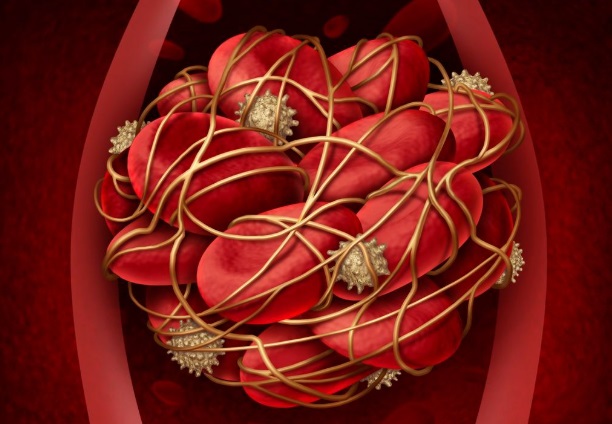SARS-CoV-2 ORF7a Protein Found to Trigger Dangerous Blood Clots, Explaining Many COVID-19 Deaths
Nikhil Prasad Fact checked by:Thailand Medical News Team Jun 23, 2025 4 months, 2 weeks, 3 days, 15 hours, 32 minutes ago
Medical News: In a new breakthrough, researchers have uncovered a critical clue behind the deadly blood clot complications often seen in patients with severe COVID-19. A protein made by the SARS-CoV-2 virus, known as ORF7a, appears to directly activate the lining of blood vessels and cause the release of von Willebrand factor (VWF), a sticky substance that promotes blood clot formation. This alarming finding may explain why so many infected individuals develop life-threatening clots despite early anticoagulant therapy.
 SARS-CoV-2 ORF7a Protein Found to Trigger Dangerous Blood Clots, Explaining Many COVID-19 Deaths
SARS-CoV-2 ORF7a Protein Found to Trigger Dangerous Blood Clots, Explaining Many COVID-19 Deaths
This
Medical News report is based on work conducted by scientists from several leading institutions: the University of Kansas Medical Center, the Second Xiangya Hospital of Central South University in China, the University of Maryland School of Medicine, and the U.S. Food and Drug Administration’s Center for Biologics Evaluation and Research.
The Hidden Threat Inside the Virus
Since the start of the COVID-19 pandemic, one puzzling aspect has been the high number of patients who suffer strokes, heart attacks, and lung blockages due to blood clots. These events were especially common in those severely ill or in intensive care. While doctors observed high levels of clot-promoting VWF in the blood, the underlying reason remained unknown—until now.
Using fruit flies and human and mouse cells, the researchers zeroed in on a viral accessory protein called ORF7a. In fly models, the presence of this viral protein led to sticky clots in their equivalent of blood. When human and mouse endothelial cells—the cells that line blood vessels—were exposed to ORF7a, they released massive amounts of VWF.
ORF7a Forces Blood Vessels to Release Clotting Material
ORF7a doesn’t act alone. It triggers the release of ultra-large VWF strands from special storage packets in blood vessel cells called Weibel-Palade bodies. These sticky VWF strands encourage platelets to clump together, setting the stage for blood clots. Even more concerning, the viral protein exists in both a membrane-bound and a soluble form, meaning it can spread through the body and affect distant blood vessels.
The scientists confirmed this clot-triggering mechanism in real-time by using a microfluidic device simulating blood flow. They watched platelets stick aggressively to endothelial cells exposed to ORF7a. The effect was especially strong in mice lacking ADAMTS13, an enzyme that normally cuts down the size of VWF strands and prevents clotting. When ADAMTS13 or the anti-clotting drug caplacizumab was added, the excessive clotting was reduced—suggesting potential treatment strategies.
Why This Matters
This discovery reveals that even a small viral protein like ORF7a can unleash a cascade of life-threatening events. It may help explain why COVID-19 patients often develop blood clots despite treatment and why mortality remains high in
severe cases. Researchers also noted that inflammatory cytokines induced by ORF7a can further boost VWF release while reducing ADAMTS13 levels, worsening the imbalance and creating a perfect storm for clot formation.
Important Clues from Genetic Studies
RNA sequencing of endothelial cells treated with ORF7a revealed massive changes in gene expression. Genes related to metabolism, cholesterol production, and cell signaling were highly active, while protective genes like those for extracellular matrix proteins were suppressed. This suggests ORF7a rewires cell function, turning them into VWF-releasing machines.
Possible Solutions and Future Research
Given the damage caused by VWF accumulation, scientists propose that treatments targeting the VWF-platelet interaction could reduce clot-related deaths in COVID-19. Recombinant ADAMTS13 or caplacizumab, already in use for other blood clotting disorders, might hold promise as emergency treatments for severe COVID-19 patients.
A Dangerous Weapon in the Virus’s Arsenal
While many studies have focused on the spike protein of SARS-CoV-2, this new research shifts attention to the virus’s lesser-known components. ORF7a is just one of many viral proteins, but its ability to hijack the blood’s clotting system makes it a major threat. Future vaccines and antiviral strategies may need to target such non-spike proteins to provide broader protection.
The study findings were published in the peer reviewed journal: Research and Practice in Thrombosis and Haemostasis.
https://www.sciencedirect.com/science/article/pii/S2475037925002717
For the latest COVID-19 News, keep on logging to Thailand
Medical News
Read Also:
https://www.thailandmedical.news/news/new-study-finds-that-covid-19-thrombosis-behaves-differently-from-normal-blood-clot-cases
https://www.thailandmedical.news/news/platelets-of-those-infected-with-covid-19-exhibit-dangerous-imbalance-that-may-explain-blood-clot-risks
https://www.thailandmedical.news/news/red-blood-cell-fragments-and-dying-blood-vessels-may-be-the-real-cause-of-covid-19-related-organ-damage
https://www.thailandmedical.news/articles/coronavirus
